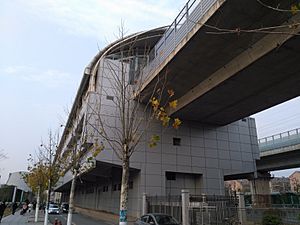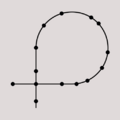Rapid transit facts for kids
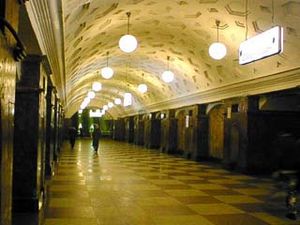
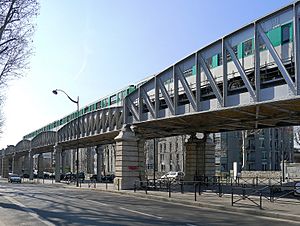
Rapid transit is a special type of railway system. It uses trains that run very often and can carry many passengers at once. You'll usually find these systems in big cities or busy areas, helping people travel quickly in and out of the city center.
These trains move very fast because they don't share the road with other traffic. Most rapid transit railways don't have level crossings where cars and trains meet. Instead, their tracks go over or under other roads, or they run in tunnels or over bridges. This way, they stay separate from other vehicles.
Many places call their rapid transit system a metro. Other common names around the world include subway, underground, tube, elevated, or heavy rail. These names sometimes describe how the system is built. For example, some systems are completely underground, while others are entirely above ground. Some even have parts that are both below and above ground.
A single rapid transit system can have many different lines that go to various places. It also has many stations where people can get on and off trains. Sometimes, you can even switch to other types of public transport at these stations. Lines often have special stations where you can change from one line to another to go in a different direction. These are called interchange stations. The biggest rapid transit systems have many of these important stations.
Contents
Europe's First Rapid Transit Systems
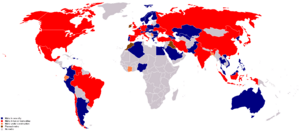
Many people believe the very first rapid transit system was the Metropolitan Railway in London, the capital of the United Kingdom. Construction for what would become the London Underground began in 1860. The first part of the line opened in 1863.
Early underground trains were powered by locomotives that burned coal. The smoke from these trains caused problems for people in the tunnels. Later, trains on the line switched to electric power. This original line is still running today as part of the Metropolitan line.
Another London railway, the City and South London Railway, was the first rapid transit line to use trains powered by electricity. This part opened in 1890 and is now part of the Northern line. Over time, more underground railways were built in London. Today, the London Underground, often called the "tube" because of its small trains and tunnels, has eleven lines. Some of these lines even share tracks with regular National Rail trains.
After London, the next cities to build rapid transit lines were Budapest, Hungary, and Glasgow, Scotland. Budapest's first metro line opened in 1896, and Glasgow's "Subway" also opened in the same year. Soon, many other large European cities started building their own metro lines. These included Berlin, Germany (Berlin U-Bahn); Paris, France (Paris Métro); and Moscow, Russia (Moscow Metro).
Some lines in the Paris Métro use trains with rubber tires in addition to wheels made of steel. This design helps the trains run more smoothly, especially on steep hills. The metro system in Montreal, Canada, also uses this type of train.
Rapid Transit in the Americas
The first subway in North America was built in Boston. Construction started in 1895, and the first section opened in 1897. The tunnels from this early subway are still used by the Green Line of the Massachusetts Bay Transportation Authority (MBTA) today.
In 1904, the New York City Subway opened, serving New York City. It quickly grew and became one of the largest rapid transit systems in the world. It still has the most stations of any rapid transit system, with over 400 stops. Many more cities in the United States and Canada built their own subways. These include Philadelphia (run by SEPTA), Los Angeles (run by METRO), the Montreal Metro in Montreal, the Toronto Subway in Toronto, and the Vancouver SkyTrain in Vancouver, Canada.
While most rapid transit systems are built in underground tunnels, some lines are built above the street. These "elevated" lines are cheaper to build because they don't require digging tunnels. A famous elevated rapid transit system is the Chicago 'L', which has served Chicago since 1892. The New York City Subway also has many elevated sections.
Newer rapid transit systems in the US include the Bay Area Rapid Transit (BART) in the San Francisco Bay Area and the Washington Metro in the Washington, D.C. area. BART started running in 1972, and the Washington Metro began in 1976. These systems have long sections of track without stations and often run above ground, sometimes even in the middle of highways. However, all their lines travel through subways in the inner city areas.
The first subway in South America opened in the Argentine capital of Buenos Aires in 1913. This system, called the Buenos Aires Underground, used its oldest trains for almost one hundred years before they were replaced in 2013. Other cities in Latin America with rapid transit include São Paulo, Brazil (São Paulo Metro); Santiago, Chile (Santiago Metro); and Mexico City, Mexico (Mexico City Metro). Like Paris and Montreal, the trains in Santiago and Mexico City use rubber tires.
Even though fewer cities in Latin America have rail-based rapid transit compared to Europe, many large cities use bus rapid transit networks. These systems carry many people, similar to railways, and often have their own special lanes on roads. They use buses instead of trains. These bus systems are often designed so they can be changed into rail-based rapid transit in the future.
Rapid Transit in Asia, Africa, and Australia
The first subway in Asia was in Tokyo, Japan. The first section, part of the Ginza Line, opened in 1927. Today, Tokyo has 13 lines run by two different companies (Tokyo Metro and Toei Subway). Many trains on these lines, called "through trains," can run directly onto regular Japanese railways. Other cities in Japan also have their own subways, such as Osaka, Kyoto, and Nagoya.
In China, the first subway, the Beijing Subway, opened in Beijing in 1969. Since then, many other Chinese cities have built subways, including Tianjin, Shanghai, and Guangzhou. These systems, especially Beijing with its 18 lines, have become some of the largest and longest in the world. For example, the Shanghai Metro had only one line when it opened in 1993, but now it has 14 lines. Both the Beijing and Shanghai systems have over 500 kilometers (about 310 miles) of track.
Other Asian cities with large subway systems include Taipei, Taiwan (Taipei Metro); Seoul, South Korea (Seoul Metropolitan Subway); Delhi, India (Delhi Metro); and Singapore (MRT). Three of Singapore's MRT lines, along with three smaller LRT lines, are automatically operated, meaning they run without a driver. A few other metro systems that operate this way are London's Docklands Light Railway; the SkyTrain in Vancouver, Canada; and the Dubai Metro serving Dubai in the United Arab Emirates.
Africa does not have many cities with rapid transit systems. The oldest one is in Cairo, Egypt (Cairo Metro), which has been in use since 1987. Some cities in South Africa have commuter rail networks with trains that run very often, similar to rapid transit.
Australia was the last continent to get a rapid transit system. Its biggest cities already had large commuter rail networks, some of which run in tunnels like rapid transit. The first rapid transit system in Australia opened in Sydney (Sydney Metro) in 2019. It also uses driverless trains.
Related pages
Images for kids
-
The London Underground is the world's oldest underground system.
-
The New York City Subway is the world's largest single-operator rapid transit system by number of metro stations, at 472.
-
A crowded Paris Métro mean station platform in 2007
-
A station of the Guangzhou Metro in 2005
-
Initial construction stages of London's Metropolitan Railway at King's Cross St Pancras in 1861.
-
Ana Rosa station platform, line 2 in São Paulo Metro.
-
Tokyo Metro uses large LCD information display to show the current location, upcoming stops, and advertisements in several languages (Japanese, English, Traditional Chinese, Simplified Chinese, Korean).
-
Platform-edge doors are used for safety at Daan Station on the Red Line (Tamsui-Xinyi Line), Taipei Metro, Taiwan.
-
DAS antennas, such as this one installed by Transit Wireless in a NYC Subway station, are commonly used to provide cellular reception in metro stations.
-
Inside a tunnel on the Turin Metro, the interlocking tunnel lining segments placed by a tunnel boring machine can be clearly seen.
-
Landungsbrücken station in Hamburg is an example where the U-Bahn is on the surface while the S-Bahn station is on a lower level.
-
Constructing a subway station Prosek in Prague.
-
The Sportivnaya station of the Saint Petersburg Metro has 2 levels.
-
Trains on the North East MRT line in Singapore are fully automated and are not operated by any driver.
-
Stratford Station in London is shared by London Underground trains (left) and main line rail services (right), as well as the Docklands Light Railway (not shown).
-
The Docklands Light Railway in London allows for dense land use, while retaining a high capacity.
See also
 In Spanish: Metro (sistema de transporte) para niños
In Spanish: Metro (sistema de transporte) para niños


